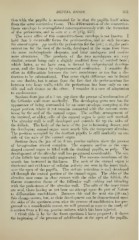Page 621 - My FlipBook
P. 621
DENTAL RIDGE. 631 ;
tion with the papilla is accounted for in that the papilla itself arises
from the same connective tissue. This diiferentiation of the connective-
tissue envelope is accomplished contemporaneously with the formation
of the periosteum, and is seen at c. ct. (Fig. 357).
The exact office of this connective-tissue envelope is not known. I
hold that it eventually forms the pencementuvi, and as such becomes
the cement organ, pp marks the periosteum for the jaw ; c. cL, the peri-
cementum for the root of the tooth, developed at the same time from
the same embryoplastic elements, and later analogous and contin-
uous structures. The products of the two membranes are very
similar, cement being only a slightly modiiied form of cortical bone
which latter, as we have seen, is formed by subperiosteal develop-
ment, and the former by subpericemental ossification. I consider the
effort to differentiate between the two membranes as too fine a dis-
tinction to be substantiated. That some slight difference can be found
no one doubts, but it arises from the fact that the pericementum lies
between two bony walls, while the periosteum has bone only on one
side and soft tissues on the other. I consider it a case of adaptation
to environment.
Sections from jaw of a 7 cm. pig show the process of condensation of
the follicular wall more markedly. The developing germ now has the
appearance of being surrounded by an outer envelope, excepting at the
upper portion, where it yet remains connected with the mucous mem-
brane by the neck of the enamel organ. The stellate arrangement of
the internal, or older, cells of the enamel organ is quite well marked.
The alveolar wall is well developed and extends far up the sides of
the follicle. The body of the bone of the jaw is becoming denser, and
the developing enamel organ more nearly fills the temporary alveolus.
The position occupied by the dentinal papilla is still markedly on one
side of the axis of the enamel organ.
Sections from the jaw of an 8 cm. porcine embryo show the process
of invagination almost complete. The concave surface of the cup-
shaped enamel organ is filled with the dentinal papilla, or pulp. The
development of the alveolar wall has progressed considerably. The size
of the follicle has materially augmented. The mucous membrane of the
mouth has increased in thickness. The neck of the enamel organ is
shortened and evidences of cellular activity are seen in the inner tunic,
over the apex of the papilla. The stellate reticulum is well developed
all through the central portion of the enamel organ. The sides of the
alveolus now come in close contact with the sides of the follicle, the
fibrous connective tissue of the follicular wall uniting and blending
with the periosteum of the alveolar wall. The cells of the inner tunic
are oval, there having as yet been no attempt u]:>on the part of Nature
to differentiate ameloblasts. Between this and the next size (10 cm.)
this change occurs, but, as their development can be demonstrated upon
the sides of the specimen even after the process of amelification has pro-
gressed to a considerable extent, we will proceed at once to the study of
a section from a 10 cm. porcine embryo which has been injected.
I think this is by fiir the finest specimen I have prepared ; it shows
the beginning of the process of calcification at the apex of the papilla.


